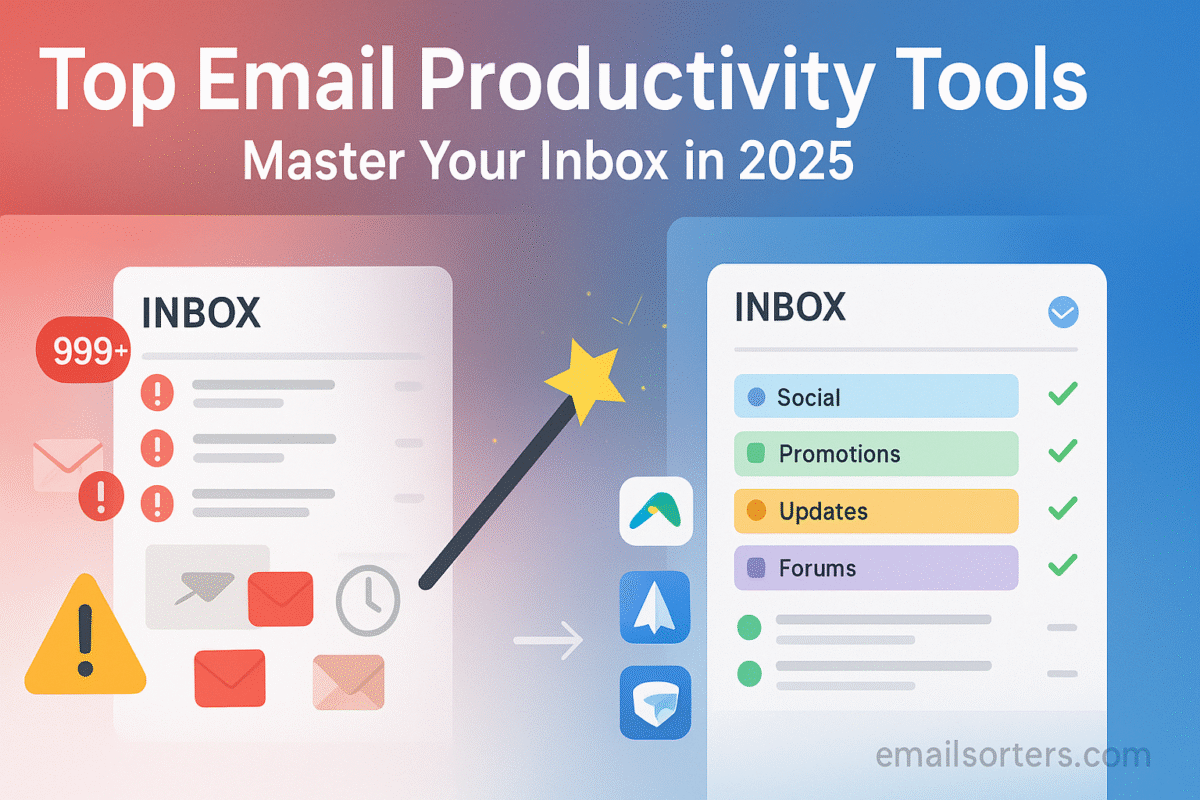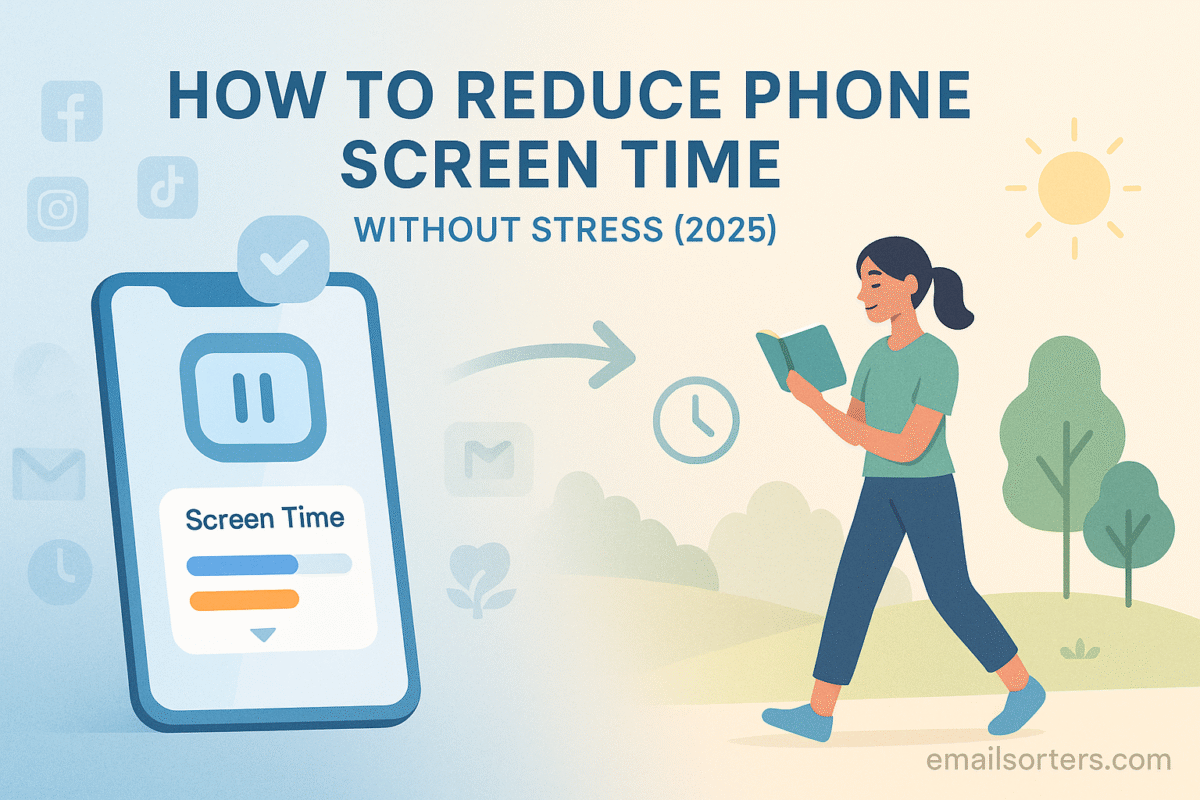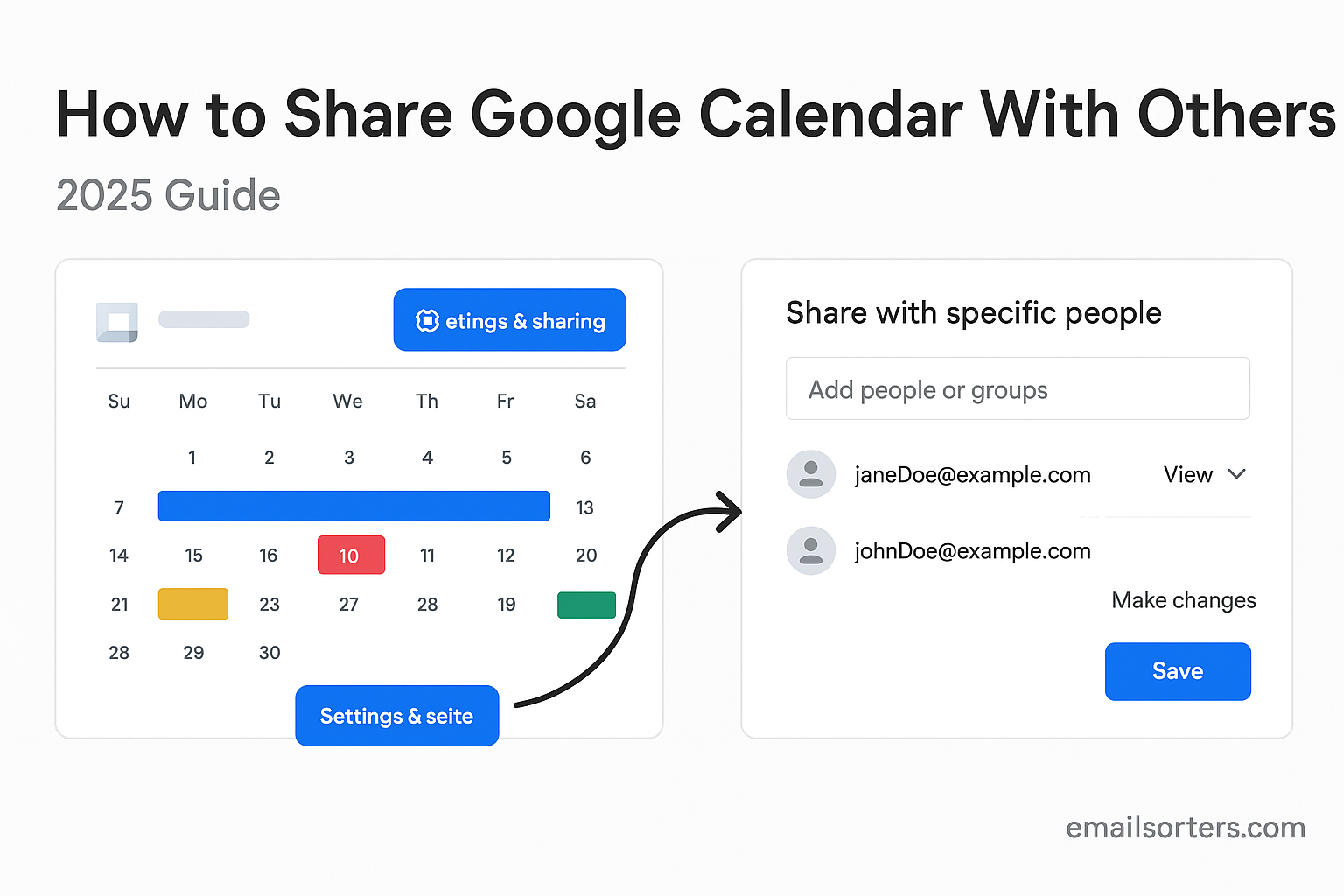Email hasn’t gone anywhere. Despite dozens of communication platforms and instant messaging apps, email remains a cornerstone of work communication. From formal correspondence to client requests, calendar invites, and service updates, your inbox is still where most business flows begin. But while its importance hasn’t changed, the volume and speed of email have increased. Today, most professionals receive more messages than they can process, and it’s wearing people down.
A cluttered inbox creates anxiety. It turns a communication tool into a daily stressor. You read one message and five more appear. Important notes get buried under newsletters or threads you were CC’d on by default. Responding to email becomes a task in itself; one that steals attention from deeper work.
The good news is that smarter tools have emerged to meet this challenge. These aren’t just new email clients with sleeker interfaces; they are powerful email productivity tools designed to help you manage your inbox efficiently, sort priority from noise, and regain focus. From AI-powered email tools that predict your responses to apps that automatically categorize, delay, or summarize messages, you now have real support in handling email.
But tools are only part of the equation. To truly master email, you also need to rethink how you use it. It’s not just about responding faster. It’s about building a system where email serves your goals, not the other way around. In this guide, we’ll explore the best email clients 2025 has to offer, examine their real-world applications, and explain how each one helps users clean up their inbox and manage email with more clarity and less stress.
What Makes an Email Productivity Tool Actually Useful?
With so many tools claiming to boost productivity, it’s important to define what makes one actually useful. A great email productivity tool doesn’t just offer features. It solves problems you deal with every day; like missed emails, endless threads, and scattered follow-ups. It should reduce the number of decisions you have to make while improving the clarity of your communication flow.
One critical feature is smart sorting. This includes categorization based on sender behavior, keywords, or urgency. Some tools use machine learning to highlight emails you’re likely to act on while moving distractions like promotional emails into a separate folder. These aren’t hard filters; they adapt to how you engage with email over time, making your inbox smarter the more you use it.
Another key element is seamless integration. Your email doesn’t exist in isolation. A useful email tool works with your calendar, task manager, cloud storage, and collaboration apps. Whether it’s turning an email into a task, pulling up meeting availability, or attaching files from your drive, the fewer clicks you need, the better the workflow.
Then there’s the interface. A clean email interface makes all the difference. It doesn’t just look nice; it reduces mental load. Cluttered layouts with too many buttons slow you down. Simplicity makes processing messages faster and easier.
And finally, automation. The best tools help you schedule sends, delay incoming emails, create templates, and even write responses. This is where AI-powered email tools truly shine; removing the need to repeat the same small tasks every day.
When you combine smart sorting, clean design, strong integrations, and meaningful automation, you get a tool that doesn’t just improve your inbox; it transforms it into something manageable.
Superhuman: Speed Meets Simplicity
Superhuman is designed for people who want to spend less time on email and get more done in the process. Unlike traditional email clients, Superhuman focuses on speed and minimalism. It strips away visual noise and focuses on keyboard-driven workflows that help you get through your inbox fast.
The app loads instantly and is optimized for zero lag. Every action; from archiving to replying; can be done with keyboard shortcuts. This might sound like a small thing, but when you’re handling hundreds of messages a week, those saved seconds add up fast.
What makes Superhuman unique is how it handles triage. You get a focused inbox, where less relevant emails are moved aside. You also get reminders for messages you’ve sent but haven’t received a reply to. These “follow-up nudges” are automatic and help you stay on top of conversations without extra tracking.
The tool includes email templates, delayed sending, and read receipts; all built to flow with minimal effort. There’s even a calendar preview that shows availability inline while writing a message, so you don’t have to open another window to suggest times.
But Superhuman isn’t for everyone. It’s best suited for professionals who live in their inbox; founders, executives, sales leads; who want a cleaner way to manage email. It’s less about feature overload and more about fast, focused control. With pricing that reflects its premium positioning, it’s an investment in saving time; not a casual upgrade.
For those overwhelmed by bloated interfaces and constant clicks, Superhuman offers a return to email clarity. It doesn’t just change how you do email. It changes how you think about it.
Clean Email: Bulk Organizing Made Easy
For people with inboxes already overflowing, Clean Email is a lifeline. This inbox management software focuses on helping users sort and clean up large amounts of email quickly. Instead of forcing you to go message by message, it groups emails into smart bundles; letting you delete, archive, or label hundreds at once based on patterns.
What makes Clean Email stand out is its emphasis on batch actions. You can remove all emails from a sender, unsubscribe from newsletters in bulk, and even apply rules to future emails from the same source. That means once you’ve cleaned your inbox, it stays clean.
The tool doesn’t just focus on deletion. You can move emails into folders, mark them as read, or flag them for later. And it works across all major email providers, so whether you’re using Gmail, Outlook, or Yahoo, it connects easily and works right away.
One of its best features is the Auto Clean function. You can set rules like “delete promotions after 30 days” or “archive receipts weekly,” and the tool handles them for you. This turns email maintenance from a task into something that runs in the background.
It also includes a privacy-first design. Clean Email doesn’t read or store the contents of your messages. Instead, it looks at headers and metadata to perform its cleanup functions. That’s key for users who want better control without sacrificing security.
For anyone buried under a decade of email; or just trying to start fresh; Clean Email helps bring order to the chaos. It’s not a replacement for your email client, but it’s the perfect companion for cleaning things up.
Spark Mail: Collaboration Meets Smart Emailing
Email has traditionally been a solo activity, but Spark Mail turns it into a team sport. Designed for businesses and remote teams, Spark adds a collaborative layer to email that makes shared inboxes and team replies easier to manage.
You can create shared drafts, discuss email replies with teammates directly inside the thread, and assign emails as tasks. This turns email into something more dynamic; more like a project management space, and less like a one-way communication stream.
Spark also includes smart sorting that prioritizes emails from real people, moving less important items like promotions or notifications into separate views. This helps you focus on what matters without manually filtering every message.
Another feature that stands out is Smart Replies. These are suggested quick responses based on the context of the message. While this feature isn’t unique to Spark, the suggestions feel natural and save time during repetitive email threads.
Spark integrates well with calendars, file-sharing apps, and task managers, making it easy to move from conversation to action. For example, a client request received via email can quickly become a to-do in your team’s project app.
Its design is clean and easy to navigate. Unlike tools built for individual power users, Spark is built to scale across teams. Everyone from freelancers to customer support teams can benefit from its flexible workflows and real-time collaboration tools.
If your team still sends endless Slack messages about email replies, Spark can replace that chaos with a smoother, shared system. And for solo users, it’s still one of the best email clients 2025 has to offer, thanks to its smart features and thoughtful interface.
Hey Email: Designed for Focused Communication
Hey Email brings a completely new approach to inbox management by reimagining how emails reach you in the first place. Rather than filtering messages after they land in your inbox, Hey asks you to screen senders before they ever appear. This flips the usual model and gives users total control from the beginning, which is perfect for people who want to reduce digital noise and regain peace of mind.
The moment a new sender contacts you, you’ll be prompted to accept or reject their presence in your inbox. This “screening” step means only approved people and services can reach you directly. Everything else is sorted away. For users overwhelmed by unsolicited emails or cold outreach, this single feature alone makes Hey one of the most powerful focus email apps available today.
Hey also divides your inbox into three distinct sections: the Imbox (important messages), The Feed (newsletters and updates), and Paper Trail (receipts and confirmations). This natural separation keeps your primary inbox reserved for real conversations, while letting you keep track of useful, but less urgent messages.
Another major benefit is its built-in note-taking. You can add comments to any email; for your eyes only; which helps you keep track of context, reminders, or follow-up steps. This eliminates the need to bounce between email and a separate notes app.
Search functionality is robust and blazing fast, even if you have thousands of messages. Threads are displayed cleanly, without the confusing quote-chains seen in older clients. Hey also supports built-in file views, making it easier to find attachments sent weeks ago without needing to dig through emails.
For those tired of endless spam, marketing clutter, and impersonal design, Hey offers a fresh, human-first interface. It doesn’t chase legacy systems; it rethinks email from the ground up. It may take a little adjustment, but once users settle in, many say they never want to go back.
Loop Email: Email and Team Chat Combined
Loop Email aims to eliminate the inefficiency that comes from bouncing between email, chat, and task tools. Built primarily for teams that handle a high volume of external communication; like customer service teams, client-facing professionals, or internal departments; Loop integrates traditional email with instant messaging, shared inboxes, and internal chat.
What sets Loop apart is how it enables conversations around emails without cluttering the original thread. Instead of forwarding or replying with endless CCs, team members can comment privately on any email. This internal conversation remains invisible to the original sender and keeps everyone aligned on how to respond.
Loop also features shared inboxes that multiple team members can access and manage together. This is useful for support teams, sales departments, or any group managing inquiries from clients or customers. With built-in task assignment, you can route an incoming email to the right person and track it until resolution; all without leaving the platform.
The interface is structured like a modern chat app but built on top of a functional email client. This blend gives Loop a very natural learning curve, especially for teams used to Slack or Microsoft Teams. It doesn’t try to replace those tools but gives email more flexibility and function, especially when conversations need to happen quickly.
Its automation features aren’t as advanced as some competitors, but its focus on transparency and accountability makes it stand out. Managers can see which emails have been assigned, what’s in progress, and how long responses are taking; all from a central dashboard.
For businesses dealing with group email chaos or remote teams looking for a more aligned email process, Loop offers an all-in-one approach that saves time and reduces miscommunication. It’s less about fancy features and more about practical alignment between email and action.
Mailbird: A Unified Inbox for Busy Professionals
For users managing multiple email accounts, Mailbird is an incredibly practical solution. Designed for those who toggle between personal, business, and project-specific accounts, Mailbird brings everything into one streamlined interface without losing speed or clarity.
It’s more than just a place to read emails. Mailbird includes features like unified search, customizable layout, and deep integrations with popular productivity apps like Trello, Slack, Google Calendar, and Dropbox. This means you can turn an email into a task, event, or chat conversation without opening another tab.
Customization is where Mailbird really shines. Users can personalize the sidebar, colors, themes, and layout to create a workspace that feels intuitive. Unlike many web-based clients, Mailbird is a desktop-first app built for speed. This gives it a performance edge for users who spend hours a day managing messages.
Its snooze, reply later, and quick preview options allow you to organize emails based on your schedule, not just when they arrive. These small touches help professionals prioritize better and avoid distraction-heavy inboxes.
While Mailbird doesn’t have the same AI depth as newer tools, it supports third-party add-ons that can extend its automation features. This gives you more flexibility if you already use tools for scheduling, CRM, or file management.
For professionals juggling multiple roles or inboxes, Mailbird is a top-tier email productivity tool. It offers the right mix of simplicity, speed, and adaptability; making email feel like a central hub again instead of a fragmented chore.
Front: Shared Inboxes Reimagined for Teams
Front is a tool built for modern teams who rely on shared inboxes to stay in sync with customers, vendors, or internal departments. But unlike generic email clients, Front combines the structure of helpdesk software with the familiarity of a personal inbox. This makes it ideal for customer support teams, account managers, or any group that works collaboratively inside a shared email environment.
At the heart of Front is the idea of assigning ownership. Every message in a shared inbox can be assigned to a specific team member, reducing confusion over who should reply. This helps eliminate missed emails, duplicate responses, or last-minute fire drills when no one followed up. Front also allows for internal discussions within threads; teammates can leave comments or ask questions without adding noise to the conversation with the sender.
What sets Front apart is how it mirrors the speed and usability of personal email, while giving teams access to powerful productivity features. You can set response SLAs, automate follow-ups, build templates, and track analytics on email response time and volume. This makes it easier for teams to measure performance without relying on separate support systems.
Front integrates well with CRMs, calendars, task tools, and customer databases. That means you can view client history, update pipelines, or log activity directly from the inbox. For teams managing high-touch relationships, this unified view can significantly reduce toggling between tools and improve client communication.
Front’s design is sleek but functional. It doesn’t overwhelm users with settings or dashboards but gives you everything you need to manage both individual and shared messages. Whether you’re part of a small team or a department with dozens of collaborators, Front helps ensure your inbox runs like a system, not a mess.
Shortwave: Google’s Inbox Reborn for the Modern Era
When Google shut down its experimental Inbox app, a void was left for users who preferred organized, categorized, and minimal email experiences. Shortwave fills that gap; and then takes it a step further. Built by former Google employees, Shortwave brings the clean, bundled email interface back, this time with more power and personalization.
Shortwave automatically groups emails into bundles like “Newsletters,” “Promotions,” and “Updates.” These bundles keep low-priority messages out of your way while allowing you to review them all at once when you’re ready. You don’t need to create dozens of filters manually; the app learns how you engage with each type of message and adjusts over time.
The interface is designed for clarity. Threads are condensed, attachments are shown with previews, and actions like snoozing, archiving, and labeling happen with a single tap or keystroke. There’s also a helpful summary mode, which can distill long email threads into quick overviews; saving you time when catching up.
Shortwave’s productivity features include quick replies, message pinning, undo send, and real-time notifications. You can also schedule emails or mute entire threads if they’re no longer relevant. And because it works directly on top of Gmail, you don’t lose any of your existing data or account structure.
It also includes collaboration features for teams. Shared threads, comments, and quick assignment tools help small groups stay on the same page without forwarding emails endlessly.
For Gmail users who miss the clarity of the old Inbox experience, Shortwave feels like a well-executed upgrade. It’s ideal for users who value structure, minimalism, and control in how they process communication.
To boost your inbox even further, explore Gmail Hacks that pair perfectly with tools like Shortwave.
Edison Mail: Fast, Secure, and Feature-Packed
Edison Mail is designed for speed and privacy. It’s a strong choice for users looking to manage multiple email accounts with a unified inbox and powerful automation features. Whether you’re on iOS, Android, or desktop, Edison syncs seamlessly and keeps your communication fluid across platforms.
The app automatically categorizes messages; identifying receipts, travel updates, shipping notifications, and subscriptions. This smart filtering keeps your main inbox clean, while still surfacing relevant updates when needed. You can unsubscribe from newsletters in one tap or delete entire threads with swipe gestures.
One of Edison’s standout features is the Assistant tab. This AI-powered hub pulls in important information; upcoming flights, package deliveries, calendar invites; and presents it in one place. No need to search your inbox manually; the Assistant keeps daily logistics easy to access.
Security is a major focus. Edison Mail includes built-in anti-phishing and spam protection, and it doesn’t sell user data to advertisers. In a time when privacy matters more than ever, this transparency is a big draw for many users.
There’s also a built-in undo send, snooze, and customizable swipe gestures that let you process mail your way. Unlike some heavier clients, Edison is lightweight and intuitive; ideal for professionals who want strong features without a steep learning curve.
It may not offer deep collaboration tools like Front or Spark, but as a solo productivity app, Edison delivers speed, smart features, and reliable performance.
Transform Your Inbox with the Right Strategy and Tools
Tools are only as effective as the habits behind them. You can install every top-rated app, but if you check email every five minutes or keep replying to low-priority threads, you’ll stay in the same state of overwhelm. To truly master email, you need structure; habits, boundaries, and clarity.
Start by creating blocks of time for email, rather than checking it constantly. Use snooze features or delayed delivery to stay in control of when messages show up and when you respond. Prioritize emails that drive progress; not ones that just demand attention. For more ideas on managing attention, see Stop Email Overwhelm.
Let your tools do the heavy lifting. Whether it’s auto-sorting, one-click unsubscribing, or quick-reply suggestions, lean on automation to reduce small tasks. Clean your inbox regularly, archive aggressively, and stop treating it as a to-do list.
With the right approach and the right toolset, email stops feeling like a burden; and starts working for you again.
Conclusion
Mastering your inbox in 2025 doesn’t require more effort; it requires smarter systems. With the help of modern email productivity tools, users can cut through clutter, focus on high-impact messages, and reclaim the hours once lost to sorting, replying, and firefighting. Whether you’re a solo entrepreneur, part of a fast-moving team, or a professional juggling multiple roles, the tools explored in this guide offer tailored solutions to help you manage your inbox efficiently.
The key is to choose tools that reflect your workflow. If you’re buried in newsletters and spam, start with a cleanup tool. If you need faster replies and clearer structure, try a minimal client with keyboard-driven actions. If collaboration is your pain point, go with a shared inbox system that aligns your team.
Above all, use your inbox with intention. With cleaner design, smarter features, and seamless integrations, the right email tools don’t just boost productivity; they restore peace of mind.
FAQs
1. What’s the best email productivity tool for teams?
Front and Spark both offer shared inboxes, internal comments, and task assignment, making them ideal for teams managing client communication or support tickets.
2. Are AI-powered email tools safe for sensitive data?
Most leading tools, like Superhuman and Edison, offer end-to-end encryption and do not store or sell your data. Always review privacy policies before use.
3. Which tool is best for cleaning a cluttered inbox quickly?
Clean Email is purpose-built for bulk actions like mass unsubscribes, archiving, and deleting outdated messages; all in a few clicks.
4. Can I use these tools across multiple accounts?
Yes. Tools like Mailbird and Edison support unified inboxes and allow seamless switching between multiple accounts, both personal and professional.
5. How do I reduce the time I spend on email daily?
Use batching, automation, smart triage features, and schedule-specific email times. Tools that offer snoozing, scheduled sends, and AI replies can dramatically reduce daily email effort.




